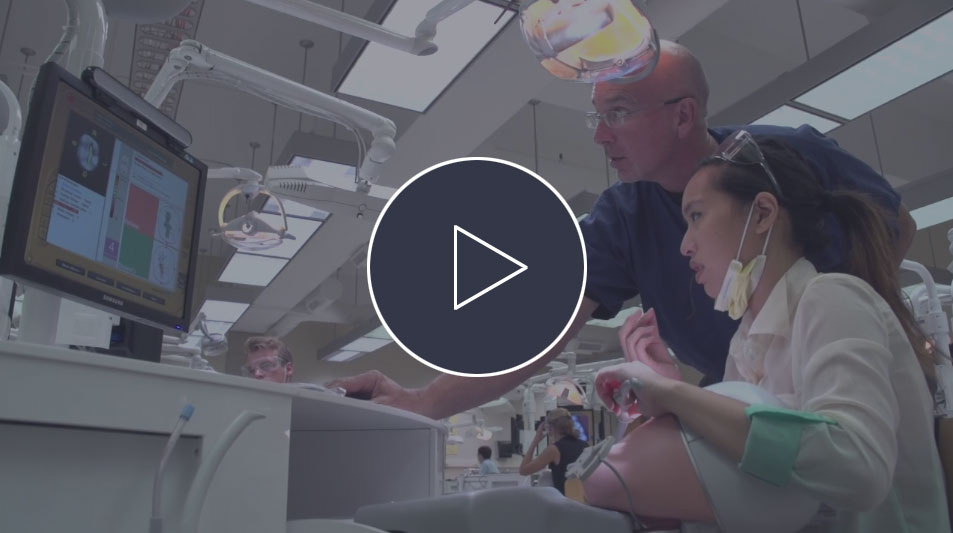DentSim
confidence. performance. preparation.How accurate is the DentSim?
How long will our investment in DentSim last?
What is involved in calibrating the DentSim units?
What has to be done to check the manufacture calibration ( pre-calibration)
Once the unit is ready to be used, it will take about 3 minutes per unit to confirm that the unit is calibrated and validated by the software.
Do Dimensions of certain DentSim preparations vary from the ideal procedures that are taught in our school?
In a traditional lab students receive feedback on the shape of the prep and, in the practical exams, they are tested on the shape of the prep that they drill. This sends an obvious message to the student – it is the shape of the prep that is important. As a result, students are less conscious of the process and can even learn and transfer process errors from the preclinic to the clinic.
DentSim Lab practice differs in that the target prep geometry is used as a vehicle to teach discrete skills that are both cognitive and psycho-motor. DentSim practice enables the student to acquire the foundational skills of a proper mental image of the tooth, proper handpiece positioning, drilling-to-depth, self-assessment capability and forward reasoning. Evaluation parameters provide skill-specific graphical and digital feedback on wall angle, handpiece position, outline shape and floor depth. Self-analysis of feedback on the individual components of the preparation self-develops the micro-skills necessary to deploy those skills in the clinic. Of course, DentSim also provides feedback on the shape that is drilled.
How does the preclinic prepare the operative dentist for the endless variety of caries and patients that he will encounter?
DentSim training provides more confidence to students entering the clinic.
How does DS practice enable students to form a mental image of the tooth?
Do I drill on a plastic simulation tooth similar to what students practice on in Dental School?
Do I receive immediate feedback as soon as I drill?
Can I apply what I learn on DentSim?
You learn skills step by step so that your skills improve in an expert method.
What types of skills will I learn?
Skills you can apply throughout your dental career. Hand-skills and Visualization skills including: • Drilling to depth • Assess long axis • Wall angles • Outline shape • Outline centralization • Retention • Handpiece positioning
What will I learn with Dentsim that I wouldn't learn with a traditional phantom simlab?
Mental Image of Tooth Essential for Hand-Skills: Student develops mental image of the tooth with DentSim. A mental image allows the students’ hand skills to have a goal to achieve. DentSim provides continuous 2 dimensional and 3-dimensional cross section feedback. This enables students to constantly visualize their prep vs. the optimal prep and create a mental image.
20-50 Feedbacks per hour after instructor guides student with drill and on-screen:
With DentSim an instructor can show a student what looks correct on screen and then the student can self-check themselves. This makes all the time between an instructor’s advice productive. An instructor cannot provide feedback at the precise moment that a student needs it; DentSim can. Without DentSim a student receives feedback 2 to 4 times an hour leaving the student wondering if they are drilling correct. Studies show students receive 20-50 feedbacks per hour with DentSim.
Focus on the Process rather than cover up mistakes:
With DentSim a student receives feedback during each stage of their prep. This allows them to prep correctly rather than cover up their mistakes at the end of their prep. Studies show that without DentSim 25% of the time a student uses to cover up their mistakes.
Specific repetitive practice of fundamental skills rather than copying shapes leads to higher learning curve of expertise:
• Drilling to depth • Assess long axis • Wall angles • Outline shape • Outline centralization • Retention • Handpiece positioning
Wall angles and parallelism to long axis visual aid: These skills are the most difficult to teach and to learn without a visual aid. A study shows DentSim allows students to learn to determine and prepare preparations in long axis in 12 hours vs 30 hours with a traditional lab. Students also learn forward reasoning.




Students are able to pull up their older sessions and review them to see if they make the same mistakes over and over again and how they are improving.
I need to start perpendicular to the occlusal table which is hard to see on the typodont but can be seen really nice on DentSim.
I would guess that students can learn in two hours what used to take six hours on benchtop. They develop the skill to learn operative dentistry.
It is important to build exactly this visual image in the students minds. The DentSim is very suiting for this purpose, because it visualizes the target cavity design compared to the actual cavity preparation by the student.

